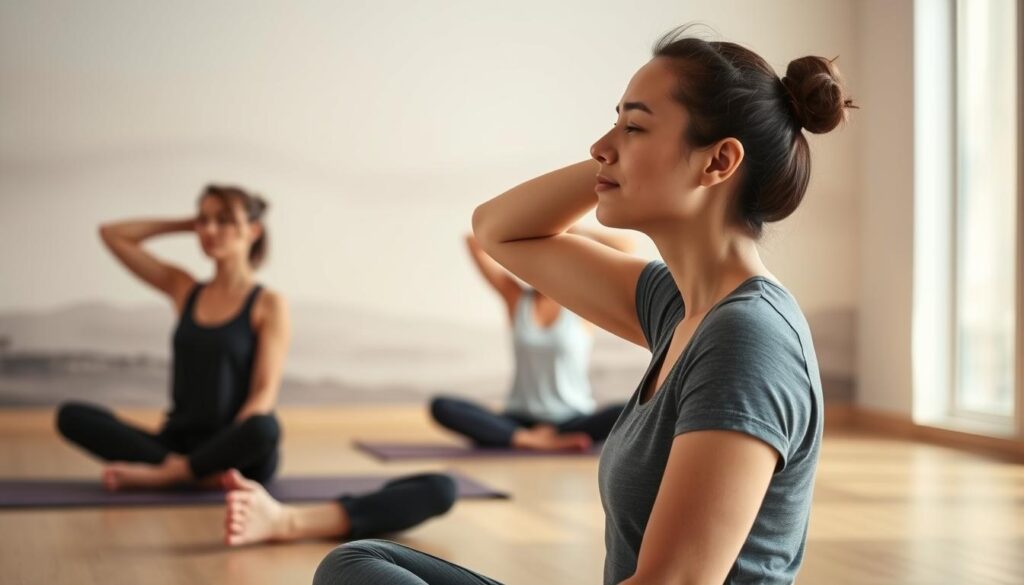Today’s world is super busy, and it’s common to have neck and shoulder pain. This piece shows how meditation can help ease that pain, adding to what regular pain relief methods do. By focusing your mind, you can lessen the pain and feel more relaxed and happy.
We will look into practical ways that meditation can calm you. These tips aim to help you live without the stress and pain.
Understanding Neck and Shoulder Pain
Neck pain is a common problem that people face. It can come from things like bad posture, doing the same motion over and over, and stress. Sometimes, health issues like arthritis can make your neck hurt too. Often, this pain moves to other parts like the shoulders, arms, and back. This can cause more trouble, including headaches.
It helps to know the different signs of shoulder pain. You might feel stiff, swollen, or just uncomfortable. This can really affect your day-to-day life. Knowing what causes this pain and the signs can help you handle it better.
Making good lifestyle choices is key to dealing with neck and shoulder pain. Staying active and setting up your workspace properly can help a lot. By taking these steps, you can feel better and improve your health overall.
How Meditation Affects Pain Management
Meditation is becoming a key method for managing pain. Those who meditate regularly often feel less neck and shoulder pain. It helps build a stronger connection between mind and body, improving pain endurance and symptom control. Meditation also helps calm the mind, changing how individuals perceive pain. This lets people face their pain without fighting against it.
Meditation offers both mental and physical benefits. It brings relaxation, which triggers the release of endorphins. Endorphins make us feel less pain. Techniques like mindfulness and guided imagery are especially helpful for managing pain.
Mindfulness has a significant impact on dealing with pain. It teaches people to stay in the moment, away from negative thoughts linked to pain. This approach helps people feel more in control of their pain. It can lead to better ways to handle pain. Meditation’s rise as a pain management tool is improving lives.
Meditation Practices for Neck and Shoulder Pain
Exploring meditation can really help with neck and shoulder pain. There are techniques like mindfulness, body scans, and guided imagery to help with discomfort. Each one offers special benefits to handle stress, tension, and pain better.
Mindfulness Meditation for Stress Relief
Mindfulness meditation focuses on the present moment. This helps calm your mind and lower stress. With less stress, your neck and shoulders can relax more, easing tension.
Body Scan Technique for Pain Awareness
The body scan technique makes you aware of specific areas, like your neck and shoulders. By noticing tension, you can work on relaxing it. This method helps you understand your pain better and spot problem areas.
Guided Imagery to Ease Discomfort
Guided imagery helps by making you visualize calming scenes. This can shift your focus away from pain. Imagining peaceful places can relax your neck and shoulder muscles, making pain easier to handle.
Integrating Yoga with Meditation
Yoga combined with meditation can deeply improve how we handle neck and shoulder pain. This mix gives a complete path to feeling better, looking at both the mind and body. Yoga helps with neck pain, bringing important gains for your health, especially through poses that lessen tension.
Benefits of Yoga Poses for Neck and Shoulder Health
Doing yoga regularly can make your neck and shoulders move better and become more flexible. Yoga makes your shoulders stronger and helps you stand straighter, preventing pain later. Studies show that moving and breathing mindfully during yoga eases tightness and stress in these areas.
Recommended Yoga Positions for Pain Relief
Some yoga poses are really good at easing pain in your neck and shoulders. Here are some to try:
- Child’s Pose – A gentle stretch that encourages relaxation of the spine and neck.
- Warrior II – This pose promotes strength in the shoulders and back while opening the chest.
- Cobra Pose – A great way to stretch the front of the body and relieve tension in the back.
- Neck Rolls – Simple movements that help alleviate stiffness and enhance circulation.
These poses, along with being mindful, boost the good effects and bring a deeper calm.

Steps to Get Started with Meditation
Starting on a meditation journey can change your life. It’s important to learn the basics of meditation if you’re new. You should begin by setting a clear goal and sticking to a regular schedule. Try to meditate for about five minutes every day, and then do it for longer times as you get better.
To build a strong start in meditation, follow these tips:
- Find a quiet place where you won’t be disturbed.
- Pick a comfortable way to sit, and use pillows or chairs to help your position.
- Concentrate on your breathing or use a soothing phrase to help focus your mind.
- Be kind to yourself as you learn to meditate and enjoy the journey.
Keeping a routine is very important. Create a meditation schedule that fits into your daily life, and try different methods to see what works best for you. This way, you’ll build a meditation practice that has real meaning for you.
Creating a Comfortable Meditation Space
It’s key to have a special spot just for meditation. This space should be quiet and free from interruptions. This lets you get into your meditation fully. Try to find a calm corner in your home, away from noise and activity.
Lighting is very important in making your meditation spot perfect. If you can, use natural light. Otherwise, warm-light lamps can make the area peaceful. An inviting place to sit is also crucial; think about adding cushions, pillows, or blankets.
Adding elements that please your senses can also improve your meditation. Scents like lavender or sandalwood make the air relaxing. Soft music can help you relax more, making it easier to concentrate on your breathing and thoughts.
Creating a good meditation space means thinking about comfort and the senses. A well-set-up space can make your meditation better and help you relax more deeply.
Common Obstacles to Meditation Practice
Many people find obstacles in meditation that interrupt their routine. A restless mind is often the main distraction, making focus difficult. Also, finding enough time adds to the challenge, making it seem hard to meditate regularly. Feeling uneasy about how to meditate can also stop people from starting.
Beating these meditation hurdles is possible with the right approaches. It helps to set goals that are achievable without feeling let down. Making meditation a daily habit, even with short sessions, lays the groundwork for lasting practice. Using mindfulness or breathing exercises can also reroute attention back to meditation, offering a fresh start.
Sticking with it is essential to move past these blocks. Meditation improvements don’t happen right away. Embracing patience and compassion towards oneself makes conquering these obstacles easier. Each little effort helps in the long run.
Conclusion
Meditation and yoga offer a strong way to handle neck and shoulder pain. These practices focus on breathing and being mindful. They help improve your health and significantly reduce pain by meditating. By understanding how our minds and bodies connect, we can live healthier.
These practices also make your mind clear and balance your emotions. Mindfulness and yoga together lessen pain and bring peace and strength. This helps us deal better with everyday stress. Trying out these meditation techniques can help you control your pain relief journey.
Thinking about using these methods means planning a daily care routine with meditation and yoga. This can make your life better. Adopting this whole approach is a key tool in seeking health and joy. It changes how you deal with pain and improves your health.



